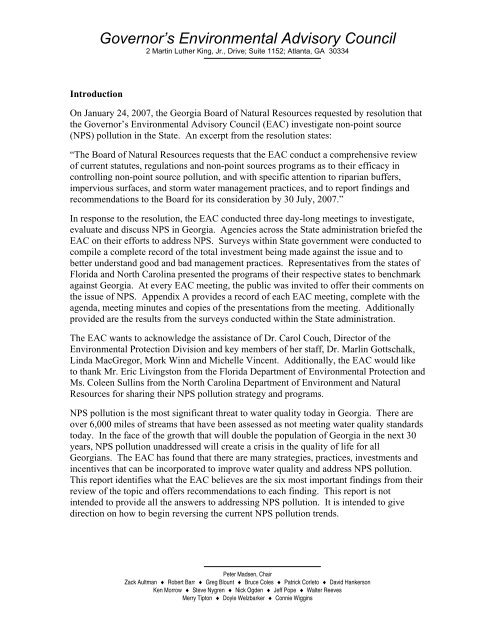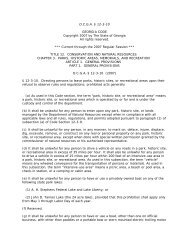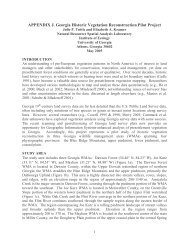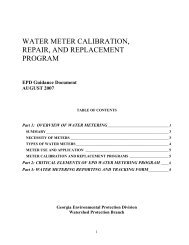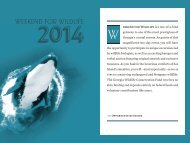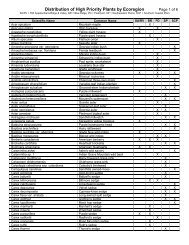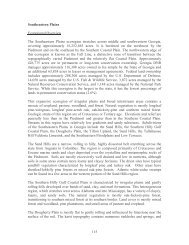Recommendations of the Environmental Advisory Council to ...
Recommendations of the Environmental Advisory Council to ...
Recommendations of the Environmental Advisory Council to ...
You also want an ePaper? Increase the reach of your titles
YUMPU automatically turns print PDFs into web optimized ePapers that Google loves.
Governor’s <strong>Environmental</strong> <strong>Advisory</strong> <strong>Council</strong>2 Martin Lu<strong>the</strong>r King, Jr., Drive; Suite 1152; Atlanta, GA 30334IntroductionOn January 24, 2007, <strong>the</strong> Georgia Board <strong>of</strong> Natural Resources requested by resolution that<strong>the</strong> Governor’s <strong>Environmental</strong> <strong>Advisory</strong> <strong>Council</strong> (EAC) investigate non-point source(NPS) pollution in <strong>the</strong> State. An excerpt from <strong>the</strong> resolution states:“The Board <strong>of</strong> Natural Resources requests that <strong>the</strong> EAC conduct a comprehensive review<strong>of</strong> current statutes, regulations and non-point sources programs as <strong>to</strong> <strong>the</strong>ir efficacy incontrolling non-point source pollution, and with specific attention <strong>to</strong> riparian buffers,impervious surfaces, and s<strong>to</strong>rm water management practices, and <strong>to</strong> report findings andrecommendations <strong>to</strong> <strong>the</strong> Board for its consideration by 30 July, 2007.”In response <strong>to</strong> <strong>the</strong> resolution, <strong>the</strong> EAC conducted three day-long meetings <strong>to</strong> investigate,evaluate and discuss NPS in Georgia. Agencies across <strong>the</strong> State administration briefed <strong>the</strong>EAC on <strong>the</strong>ir efforts <strong>to</strong> address NPS. Surveys within State government were conducted <strong>to</strong>compile a complete record <strong>of</strong> <strong>the</strong> <strong>to</strong>tal investment being made against <strong>the</strong> issue and <strong>to</strong>better understand good and bad management practices. Representatives from <strong>the</strong> states <strong>of</strong>Florida and North Carolina presented <strong>the</strong> programs <strong>of</strong> <strong>the</strong>ir respective states <strong>to</strong> benchmarkagainst Georgia. At every EAC meeting, <strong>the</strong> public was invited <strong>to</strong> <strong>of</strong>fer <strong>the</strong>ir comments on<strong>the</strong> issue <strong>of</strong> NPS. Appendix A provides a record <strong>of</strong> each EAC meeting, complete with <strong>the</strong>agenda, meeting minutes and copies <strong>of</strong> <strong>the</strong> presentations from <strong>the</strong> meeting. Additionallyprovided are <strong>the</strong> results from <strong>the</strong> surveys conducted within <strong>the</strong> State administration.The EAC wants <strong>to</strong> acknowledge <strong>the</strong> assistance <strong>of</strong> Dr. Carol Couch, Direc<strong>to</strong>r <strong>of</strong> <strong>the</strong><strong>Environmental</strong> Protection Division and key members <strong>of</strong> her staff, Dr. Marlin Gottschalk,Linda MacGregor, Mork Winn and Michelle Vincent. Additionally, <strong>the</strong> EAC would like<strong>to</strong> thank Mr. Eric Livings<strong>to</strong>n from <strong>the</strong> Florida Department <strong>of</strong> <strong>Environmental</strong> Protection andMs. Coleen Sullins from <strong>the</strong> North Carolina Department <strong>of</strong> Environment and NaturalResources for sharing <strong>the</strong>ir NPS pollution strategy and programs.NPS pollution is <strong>the</strong> most significant threat <strong>to</strong> water quality <strong>to</strong>day in Georgia. There areover 6,000 miles <strong>of</strong> streams that have been assessed as not meeting water quality standards<strong>to</strong>day. In <strong>the</strong> face <strong>of</strong> <strong>the</strong> growth that will double <strong>the</strong> population <strong>of</strong> Georgia in <strong>the</strong> next 30years, NPS pollution unaddressed will create a crisis in <strong>the</strong> quality <strong>of</strong> life for allGeorgians. The EAC has found that <strong>the</strong>re are many strategies, practices, investments andincentives that can be incorporated <strong>to</strong> improve water quality and address NPS pollution.This report identifies what <strong>the</strong> EAC believes are <strong>the</strong> six most important findings from <strong>the</strong>irreview <strong>of</strong> <strong>the</strong> <strong>to</strong>pic and <strong>of</strong>fers recommendations <strong>to</strong> each finding. This report is notintended <strong>to</strong> provide all <strong>the</strong> answers <strong>to</strong> addressing NPS pollution. It is intended <strong>to</strong> givedirection on how <strong>to</strong> begin reversing <strong>the</strong> current NPS pollution trends.Peter Madsen, ChairZack Aultman ♦ Robert Barr ♦ Greg Blount ♦ Bruce Coles ♦ Patrick Corle<strong>to</strong> ♦ David HankersonKen Morrow ♦ Steve Nygren ♦ Nick Ogden ♦ Jeff Pope ♦ Walter ReevesMerry Tip<strong>to</strong>n ♦ Doyle Welzbarker ♦ Connie Wiggins
The EAC also believes that if Georgia addresses NPS pollution in a comprehensive andcommitted manner with significant investments <strong>of</strong> people and fiscal resources, <strong>the</strong>enhanced environmental quality across <strong>the</strong> State will fur<strong>the</strong>r enhance it as a place peoplewill want <strong>to</strong> live, work and recreate. The EAC also believes that if NPS pollution is notaddressed <strong>to</strong>day, <strong>the</strong> future costs realized in a reduction in growth and quality <strong>of</strong> life and inremediation, will far exceed investment costs being discussed <strong>to</strong>day.The EAC <strong>of</strong>fers <strong>the</strong> following recommendations <strong>to</strong> address <strong>the</strong>se findings regarding NPSpollution:• Georgia needs <strong>to</strong> execute a comprehensive strategy <strong>to</strong> reduce NPS pollution.• Significant State investment is required in moni<strong>to</strong>ring and enforcement programs.• Non-point source pollution remedies are best addressed at a watershed level.• Market-based incentives and solutions must be developed.• Georgia must become aggressive in buying and protecting land parcels that willsupport <strong>the</strong> reduction <strong>of</strong> NPS pollution.• New legislation and regulation is essential <strong>to</strong> support <strong>the</strong> reduction <strong>of</strong> NPSpollution.
FindingGeorgia needs <strong>to</strong> execute a comprehensive strategy <strong>to</strong> reduce NPS pollution.There are numerous responsible entities across Georgia addressing NPS pollution <strong>to</strong>day.DNR, EPD, Forestry, Agriculture, Soil and Water Conservation, Transportation,Community Affairs, UGA and o<strong>the</strong>rs all have significant programs contributing in somemanner <strong>to</strong> <strong>the</strong> reduction <strong>of</strong> NPS pollution. During <strong>the</strong> February 8 th EAC meeting,representatives from 8 different <strong>of</strong>fices across State government discussed <strong>the</strong>ir ongoingprograms <strong>to</strong> address NPS pollution. Subsequently, a survey sent across State governmentidentified NPS pollution programs, employees doing NPS related work, and budgets,expenditures and contracts for NPS programs. It also identified results and work productsfor NPS-related contracts and programs, and <strong>the</strong> existence <strong>of</strong> any performance measuresfor NPS-related work. Attachment A has <strong>the</strong> complete compilation <strong>of</strong> <strong>the</strong> survey results.The survey results are significant, because <strong>the</strong>y represent <strong>the</strong> first time that <strong>the</strong>re has beenany compilation <strong>of</strong> <strong>the</strong> resources and programs addressing this important issue. Bot<strong>to</strong>mline, <strong>the</strong>re are numerous programs and people, and significant investment being made inGeorgia <strong>to</strong>ward <strong>the</strong> reduction <strong>of</strong> NPS pollution.Yet, NPS continues <strong>to</strong> grow as a water quality problem. Ei<strong>the</strong>r Georgia must invest morein <strong>the</strong> programs <strong>to</strong> counter <strong>the</strong> problem, or it has <strong>to</strong> get better results from its currentinvestments, or both. What was apparent <strong>to</strong> <strong>the</strong> EAC was <strong>the</strong> lack <strong>of</strong> any unified andcomprehensive strategy <strong>to</strong> address <strong>the</strong> issue. State agencies <strong>to</strong>day are acting in anindependent manner attacking NPS pollution. Undoubtedly, some programs aresucceeding and o<strong>the</strong>rs are not. Some programs may have substantial resources, o<strong>the</strong>rs donot. There is no established means <strong>to</strong> synchronize efforts or cross-level resources.Georgia needs a comprehensive strategy <strong>to</strong> reduce NPS pollution. Such a strategy wouldidentify short term and long range goals for <strong>the</strong> State, and additionally identify individualperformance measures for each State agency contributing <strong>to</strong>ward <strong>the</strong> goals. A lead agencyneeds <strong>to</strong> be identified, and <strong>the</strong> EAC recommends that EPD be that agency responsible forsynchronizing <strong>the</strong> efforts across State government. Periodic reviews against performancemeasures will identify where resources are available or where more investment isrequired. The reviews will serve as a means <strong>to</strong> highlight exceptional programs andinnovation. Coupled with a comprehensive moni<strong>to</strong>ring program, <strong>the</strong> State NPS pollutionteam should also be able <strong>to</strong> focus investments on <strong>the</strong> most impaired watersheds.EAC Recommendation• Create a statewide strategy <strong>to</strong> reduce NPS Pollution and a forum represented by allState agencies involved.• Establish EPD as <strong>the</strong> leader <strong>of</strong> <strong>the</strong> NPS Pollution Forum.• Establish performance measures for those agencies with people and resourcescommitted <strong>to</strong> NPS programs• Through <strong>the</strong> NPS Pollution Forum, review performance, moni<strong>to</strong>r progress, andfocus resources where most needed and where <strong>the</strong>y yield <strong>the</strong> greatest benefits.3
FindingSignificant State investment is required in moni<strong>to</strong>ring and enforcement programs.Currently, approximately 20% <strong>of</strong> <strong>the</strong> state’s waters are tested [for water quality] according<strong>to</strong> <strong>the</strong> Draft Submission <strong>to</strong> <strong>the</strong> Water <strong>Council</strong> (June 28, 2007). From informationpresented by North Carolina, Florida and EPD, this level <strong>of</strong> testing and assessment isinadequate <strong>to</strong> provide <strong>the</strong> data needed <strong>to</strong> execute a comprehensive strategy <strong>to</strong> reduce NPSpollution and <strong>to</strong> answer policy questions regarding water supply. Substantial funds arespent in Georgia for <strong>the</strong> various kinds <strong>of</strong> water quality moni<strong>to</strong>ring, data assessment, andmodeling work currently underway; however, both <strong>the</strong> regulated community andenvironmental organizations, such as <strong>the</strong> Georgia Conservancy, have expressed littleconfidence that <strong>the</strong> State is developing sufficient data <strong>to</strong> adequately inform current orfuture decision making. Without comprehensive data, all sides are left <strong>to</strong> speculateregarding <strong>the</strong> impact <strong>of</strong> future development and are unable <strong>to</strong> adequately assess <strong>the</strong>benefits <strong>of</strong> new s<strong>to</strong>rm water management programs. According <strong>to</strong> EPD, state funding forwater quality assessment has been cut in recent years, and federal contract work has beenaccordingly curtailed.EAC <strong>Recommendations</strong>• Funding for water quality moni<strong>to</strong>ring, data assessment, and modeling, withparticular focus on actual ambient moni<strong>to</strong>ring, needs <strong>to</strong> be a budget and fundingpriority supported by a strong case from EPD that <strong>the</strong> funds are used costeffectively when compared <strong>to</strong> sister states. Ensure <strong>the</strong>re is enough instream,ambient data for sound decision making.• This expanded data should be used <strong>to</strong> measure <strong>the</strong> State’s performance under acomprehensive strategy <strong>to</strong> reduce NPS pollution.• This expanded data should be used <strong>to</strong> measure and evaluate s<strong>to</strong>rm water and NPSpollution management practices implemented by local governments and <strong>the</strong>regulated community.Numerous sources expressed a concern <strong>to</strong> <strong>the</strong> EAC that <strong>the</strong> General Assembly has notfully funded Erosion and Sedimentation Inspec<strong>to</strong>rs at levels authorized by a user feesystem under amendments <strong>to</strong> <strong>the</strong> Erosion and Sedimentation (E&S) Act. We also heard <strong>of</strong>varying degrees <strong>of</strong> enforcement under this Act. In a survey prepared by EPD and sent <strong>to</strong>all agencies addressing NPS pollution, it was reported that greater than ninety percent(90%) <strong>of</strong> <strong>the</strong> construction sites covered by <strong>the</strong> State General Permits statewide aresignificantly out <strong>of</strong> compliance with permit conditions. There were also widespreadreports <strong>of</strong> inconsistent interpretation and enforcement by EPD regions and localgovernments acting as issuing authorities under <strong>the</strong> E&S Act.4
EAC <strong>Recommendations</strong>• State revenue generated from user fees under <strong>the</strong> E&S Act should be appropriated<strong>to</strong> <strong>the</strong> E&S program for enforcement <strong>of</strong> <strong>the</strong> Act.• Performance at all levels <strong>of</strong> government needs <strong>to</strong> be managed consistently as part<strong>of</strong> a comprehensive strategy <strong>to</strong> reduce NPS pollution.• Local governments need much better training and support from EPD <strong>to</strong> address andensure standardization <strong>of</strong> basic enforcement issues and improve local s<strong>to</strong>rm watermanagement programs.5
FindingNon-point source pollution remedies are best addressed at a watershed level.Geographic diversity is a significant characteristic <strong>of</strong> <strong>the</strong> State. Designing programs <strong>to</strong>address any environmental issue across a State with coastal, plain and mountain regions, aswell as agricultural, suburban and urban land uses presents a major challenge. Areassupported by surface waters for water supply must be addressed differently than areassupported primarily by underground aquifers. While <strong>the</strong> State will always play asignificant role in <strong>the</strong> reduction <strong>of</strong> NPS pollution, <strong>the</strong> problem must be broken down in<strong>to</strong>smaller parts <strong>to</strong> be properly addressed. The representatives from both Florida and NorthCarolina discussed <strong>the</strong>ir approaches with <strong>the</strong> EAC in April. North Carolina, throughlegislation, has established Basinwide Water Quality Planning and Management Plans.Florida advocates an integrated watershed management approach <strong>of</strong> planning,implementing, moni<strong>to</strong>ring and assessing water quality within a watershed area. It is withinthat watershed area that all <strong>the</strong> <strong>to</strong>ols <strong>to</strong> include s<strong>to</strong>rm water management, buffer protection,limitations on impervious areas and land use zoning, can be best applied <strong>to</strong> protect waterquality. Watershed strategies should be built upon common standards thresholdsestablished by <strong>the</strong> State. It is also within a watershed that innovative approaches such ascredit trading can be tested and evaluated. The recently published Georgia state water planendorses watershed management as <strong>the</strong> best way <strong>to</strong> protect Georgia waters. It recommends<strong>the</strong> delineation <strong>of</strong> water planning regions complemented by <strong>the</strong> establishment <strong>of</strong> waterplanning councils. It is also within a watershed that county and municipal governmentsplay a critical role <strong>to</strong> protect <strong>the</strong> waters that support <strong>the</strong>ir constituents. A water planningcouncil can be a synchronizing force <strong>to</strong> insure consistent approaches <strong>to</strong> reducing NPSpollution among <strong>the</strong> governments serviced by <strong>the</strong> common water source or within commonwatersheds. And lastly, moni<strong>to</strong>ring must be established <strong>to</strong> serve <strong>the</strong> watershed <strong>to</strong> enable<strong>the</strong> assessment <strong>of</strong> collective efforts <strong>to</strong> remedy <strong>the</strong> NPS pollution.EAC <strong>Recommendations</strong>• The State must remain responsible for establishing minimum standards <strong>to</strong> protectbuffer areas and for identifying significant or sensitive water bodies that requireenvironmental protection.• Georgia watersheds or water basins should be delineated, and regional waterplanning councils should be established <strong>to</strong> ensure <strong>the</strong> protection <strong>of</strong> water quality.• Regional watershed plans should be established <strong>to</strong> promote <strong>the</strong> reduction <strong>of</strong> NPSpollution as it applies within <strong>the</strong> watershed. Those plans will also identify <strong>the</strong> howall <strong>the</strong> NPS “<strong>to</strong>ols” (buffers, s<strong>to</strong>rm water ordinances, limitations on imperviousareas, etc) can be used <strong>to</strong> effectively reduce NPS pollution. Within watersheds,innovative pilot programs <strong>to</strong> reduce NPS pollutions should be tested.• State water quality moni<strong>to</strong>ring should support <strong>the</strong> needs <strong>of</strong> watershed councils <strong>to</strong>assess <strong>the</strong> results <strong>of</strong> <strong>the</strong>ir programs and plans.6
FindingMarket-based incentives and solutions must be developed.The EAC heard presentations on innovative and effective programs in Georgia, Florida,and North Carolina that reward property owners for preserving green space and buffers.While <strong>the</strong> outright purchase <strong>of</strong> green space was advocated by Florida as <strong>the</strong> single mostimportant fac<strong>to</strong>r in reducing NPS pollution, even Florida, with all <strong>of</strong> its resources, has notbeen able <strong>to</strong> purchase <strong>the</strong> land that is needed for adequate watershed supply protection andoverall NPS pollution reduction. Thus, programs that promote <strong>the</strong> preservation andtransfer <strong>of</strong> development rights (TDR) appear <strong>to</strong> be a necessary supplement <strong>to</strong> statepurchase and preservation <strong>of</strong> green spaces. Across <strong>the</strong> country over 200 TDR programswith varying characteristics are in place <strong>to</strong>day. Just such a program is in place within <strong>the</strong>Chattahoochee Hill County in South Ful<strong>to</strong>n County and it holds much promise <strong>to</strong>encourage development practices that have long term NPS pollution benefits withoutgovernmental restriction or takings issues.The EAC also heard extensively about how land use decisions impact pollution and how astate must try <strong>to</strong> encourage land uses that minimize harmful run<strong>of</strong>f. O<strong>the</strong>r sister stateshave fought many years over mandated riparian buffer widths and o<strong>the</strong>r regula<strong>to</strong>rymandates. These issues are not new. However, where <strong>the</strong> true conservation value <strong>of</strong> landcan be quantified and incorporated in<strong>to</strong> a market based trading system, new conservationopportunities appear possible. This approach has particular applicability in Georgia.The EAC also reviewed <strong>the</strong> issues associated with trading water pollution credits, and inparticular how trading nutrient reduction credits could help within <strong>the</strong> nutrient-richwatersheds upstream <strong>of</strong> Lakes Lanier, Alla<strong>to</strong>ona, Weise and Jackson. EPD is familiar withnumerous pollution allocation trading programs across <strong>the</strong> county.Sound market-based solutions and incentives come from understanding how <strong>to</strong> quantifyenvironmental benefits and services. Putting natural resource economics <strong>to</strong> work indecision-making will provide Georgia <strong>the</strong> ability <strong>to</strong> put market forces <strong>to</strong> work <strong>to</strong> addressenvironmental problems like NPS pollution and <strong>to</strong> promote sustainable development.EAC <strong>Recommendations</strong>• The State, through EPD, should provide funds <strong>to</strong> establish a fully functioning pilotproject that facilitates <strong>the</strong> transfer <strong>of</strong> development rights.• The State should establish a means <strong>to</strong> provide financial incentives for developers <strong>to</strong>preserve green space and create expanded riparian buffers.• EPD should establish and implement numerous pilot projects <strong>to</strong> assess waterquality trading opportunities in Georgia.7
FindingGeorgia must become aggressive in buying and protecting land parcels that willsupport <strong>the</strong> reduction <strong>of</strong> NPS pollution.Georgia recognizes <strong>the</strong> need <strong>to</strong> buy and conserve land. The 2006 Land Conservation Actestablished <strong>the</strong> process <strong>to</strong> do so. Land, in its natural state, will always be an effectivemeans <strong>to</strong> reduce NPS pollutions. Local communities, such as Cobb, Paulding and CarrollCounty have created recent greenspace initiatives <strong>to</strong> fund, acquire and preserve greenspace<strong>the</strong>reby protecting natural resources, establishing passive recreation areas and improvingquality <strong>of</strong> life. Land conservation done properly will not only reduce NPS pollution, but itcan also enhance <strong>the</strong> values <strong>of</strong> <strong>the</strong> developed land around it. Yet, in areas like MetroAtlanta, where counties are rapidly exceeding 20% <strong>to</strong>tal impervious surface cover, Georgiaand its local communities must get even more aggressive in protecting <strong>the</strong> remaininggreenspace. The State must identify <strong>the</strong> most environmentally sensitive areas; <strong>the</strong> criticalbuffers and wetland filters, and protect <strong>the</strong> lands through acquisition. Aggressiveacquisition means identifying those land parcels that are critical <strong>to</strong> reducing NPS pollutionand providing more resources <strong>to</strong> buy and protect <strong>the</strong> land. If water councils are established<strong>to</strong> serve a Georgia watershed, those councils can be a great aid in <strong>the</strong> identification <strong>of</strong>critical land parcels <strong>to</strong> reduce NPS pollutions.Georgia can also encourage land conservation through <strong>the</strong> use <strong>of</strong> incentives and <strong>the</strong> freemarket system. Regula<strong>to</strong>ry and fiscal support for Transfer <strong>of</strong> Development Rights (TDR)pilot programs like what is ongoing in <strong>the</strong> Chattahoochee Hills Country in South Ful<strong>to</strong>nCounty will encourage new patterns <strong>of</strong> development that will minimize land disturbance,protect <strong>the</strong> natural filter qualities <strong>of</strong> <strong>the</strong> land while also providing exceptional quality <strong>of</strong>life in new communities.Georgians have demonstrated by voting <strong>of</strong> tax increases on numerous occasions, thatgreenspace is important <strong>to</strong> <strong>the</strong>ir quality <strong>of</strong> life. Even in a mature statewide watershedmanagement program such as Florida, leaders recognize that <strong>the</strong> most important action <strong>to</strong>protect against NPS pollution is <strong>the</strong> acquisition <strong>of</strong> critical land areas. In <strong>the</strong> face <strong>of</strong> highpopulation growth, Georgia must get even more aggressive in <strong>the</strong> purchase and protection<strong>of</strong> land parcels that will forever reduce NPS pollution.EAC <strong>Recommendations</strong>• The State should identify critical land parcels that must be purchased and protected.• Increase State funding <strong>to</strong> support more aggressive land acquisition.• Develop additional incentives <strong>to</strong> encourage local preservation <strong>of</strong> greenspace.• Support with regulation and funding pilot TDR projects that create <strong>the</strong> marketincentive for land conservation and sustainable development in accordance with <strong>the</strong>goals <strong>of</strong> <strong>the</strong> NPS strategy.8
FindingNew legislation and regulation is essential <strong>to</strong> support <strong>the</strong> reduction <strong>of</strong> NPS pollution.From <strong>the</strong> foregoing, new legislation and regula<strong>to</strong>ry reform appear warranted <strong>to</strong> supportNPS pollution reduction and any State-Wide Water Plan <strong>to</strong> be approved by Georgia’sWater <strong>Council</strong>. The State Water Plan will likely identify legislation <strong>to</strong> address waterquality issues and specifically <strong>the</strong> reduction <strong>of</strong> NPS pollution. Representatives for <strong>the</strong>states <strong>of</strong> North Carolina and Florida that came before <strong>the</strong> EAC identified legislation andregulation as essential components <strong>of</strong> a strategy <strong>to</strong> reverse <strong>the</strong> NPS pollution trend. Therecommendations below represent four directions <strong>to</strong> enable State and local government <strong>to</strong>better address <strong>the</strong> reduction <strong>of</strong> NPS pollution.EAC <strong>Recommendations</strong>• The Growth Strategies Act <strong>of</strong> 1990 and its implementing regulations needcomprehensive reform <strong>to</strong> reflect <strong>the</strong> State’s experience and <strong>to</strong> put greater teeth in<strong>to</strong>planning documents that can promote <strong>the</strong> reduction <strong>of</strong> NPS pollution.• Georgia needs a comprehensive S<strong>to</strong>rm Water Utility Statute and model ordinance<strong>to</strong> help local governments raise <strong>the</strong> funds needed <strong>to</strong> address NPS pollution andimplement better s<strong>to</strong>rm water management ordinances.• Local governments need legislation <strong>to</strong> clearly authorize and require <strong>the</strong> registrationand recording <strong>of</strong> transfers <strong>of</strong> development rights.• New legislation may be needed <strong>to</strong> expand and streamline <strong>the</strong> State’s conservationuse easement income tax credit, so as <strong>to</strong> fur<strong>the</strong>r encourage land owners anddevelopers <strong>to</strong> preserve valuable green space and expand beyond minimum streambuffers.9


